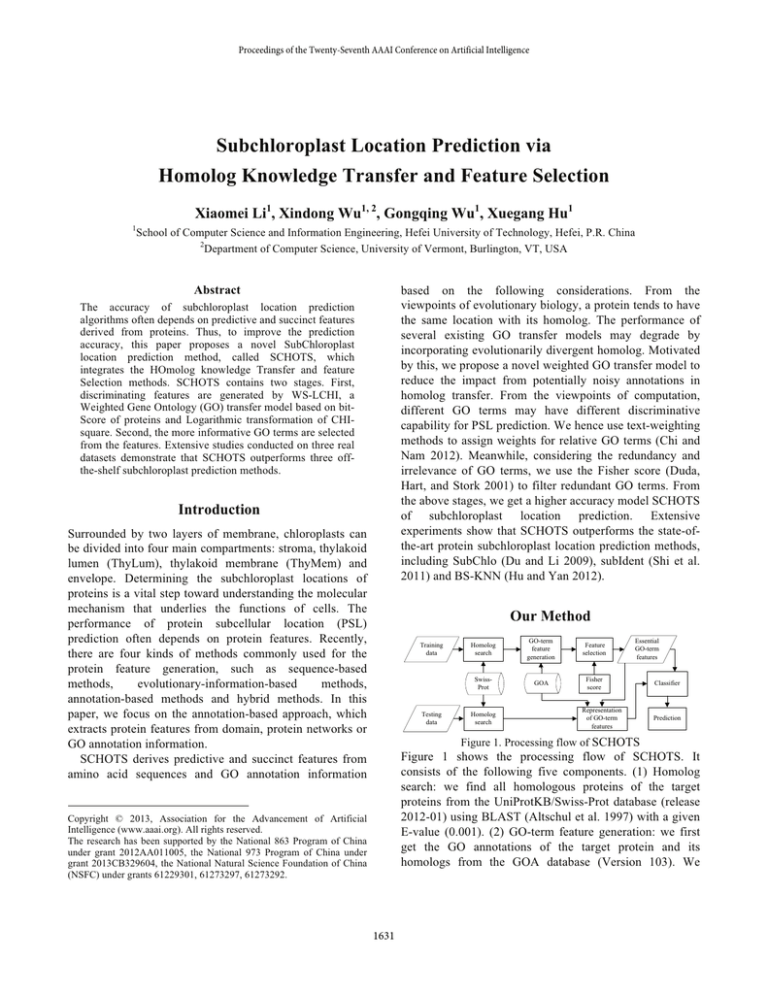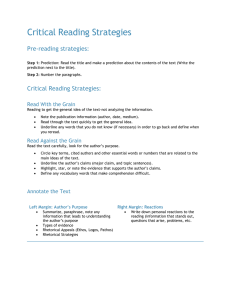
Proceedings of the Twenty-Seventh AAAI Conference on Artificial Intelligence
Subchloroplast Location Prediction via
Homolog Knowledge Transfer and Feature Selection
Xiaomei Li1, Xindong Wu1, 2, Gongqing Wu1, Xuegang Hu1
1
School of Computer Science and Information Engineering, Hefei University of Technology, Hefei, P.R. China
2
Department of Computer Science, University of Vermont, Burlington, VT, USA
based on the following considerations. From the
viewpoints of evolutionary biology, a protein tends to have
the same location with its homolog. The performance of
several existing GO transfer models may degrade by
incorporating evolutionarily divergent homolog. Motivated
by this, we propose a novel weighted GO transfer model to
reduce the impact from potentially noisy annotations in
homolog transfer. From the viewpoints of computation,
different GO terms may have different discriminative
capability for PSL prediction. We hence use text-weighting
methods to assign weights for relative GO terms (Chi and
Nam 2012). Meanwhile, considering the redundancy and
irrelevance of GO terms, we use the Fisher score (Duda,
Hart, and Stork 2001) to filter redundant GO terms. From
the above stages, we get a higher accuracy model SCHOTS
of subchloroplast location prediction. Extensive
experiments show that SCHOTS outperforms the state-ofthe-art protein subchloroplast location prediction methods,
including SubChlo (Du and Li 2009), subIdent (Shi et al.
2011) and BS-KNN (Hu and Yan 2012).
Abstract
The accuracy of subchloroplast location prediction
algorithms often depends on predictive and succinct features
derived from proteins. Thus, to improve the prediction
accuracy, this paper proposes a novel SubChloroplast
location prediction method, called SCHOTS, which
integrates the HOmolog knowledge Transfer and feature
Selection methods. SCHOTS contains two stages. First,
discriminating features are generated by WS-LCHI, a
Weighted Gene Ontology (GO) transfer model based on bitScore of proteins and Logarithmic transformation of CHIsquare. Second, the more informative GO terms are selected
from the features. Extensive studies conducted on three real
datasets demonstrate that SCHOTS outperforms three offthe-shelf subchloroplast prediction methods.
Introduction
Surrounded by two layers of membrane, chloroplasts can
be divided into four main compartments: stroma, thylakoid
lumen (ThyLum), thylakoid membrane (ThyMem) and
envelope. Determining the subchloroplast locations of
proteins is a vital step toward understanding the molecular
mechanism that underlies the functions of cells. The
performance of protein subcellular location (PSL)
prediction often depends on protein features. Recently,
there are four kinds of methods commonly used for the
protein feature generation, such as sequence-based
methods,
evolutionary-information-based
methods,
annotation-based methods and hybrid methods. In this
paper, we focus on the annotation-based approach, which
extracts protein features from domain, protein networks or
GO annotation information.
SCHOTS derives predictive and succinct features from
amino acid sequences and GO annotation information
Our Method
Training
data
Testing
data
Homolog
search
GO-term
feature
generation
Feature
selection
SwissProt
GOA
Fisher
score
Homolog
search
Representation
of GO-term
features
Essential
GO-term
features
Classifier
Prediction
Figure 1. Processing flow of SCHOTS
Figure 1 shows the processing flow of SCHOTS. It
consists of the following five components. (1) Homolog
search: we find all homologous proteins of the target
proteins from the UniProtKB/Swiss-Prot database (release
2012-01) using BLAST (Altschul et al. 1997) with a given
E-value (0.001). (2) GO-term feature generation: we first
get the GO annotations of the target protein and its
homologs from the GOA database (Version 103). We
Copyright © 2013, Association for the Advancement of Artificial
Intelligence (www.aaai.org). All rights reserved.
The research has been supported by the National 863 Program of China
under grant 2012AA011005, the National 973 Program of China under
grant 2013CB329604, the National Natural Science Foundation of China
(NSFC) under grants 61229301, 61273297, 61273292.
1631
transfer the GO terms of the protein regarding a high bitscore and a high identity (no less than 80%) calculated by
BLAST, and then we assign the bit-score and the LCHI
coefficient as weights to GO features. The bit-score
depends on sizes of the query sequence and the database,
so the coordinates of a protein feature maybe larger than 1.
Thus, the protein features are subject to a standard
conversion. (3) Feature selection: we use the Fisher score
on training datasets to determine a set of features relevant
to the predictor. The method chooses the top 50 GO-term
features with the highest F-scores computed by Fisher
score as the essential GO-term features. (4) Classifier: we
select support vector machines SVM with default settings
(=0, C=1 and RBF kernel) in Weka (Witten and Frank
2005) as the base classifier of our method. (5) Prediction:
we use the Jackknife test and single independent dataset
examination to evaluate the prediction ability.
We use the S60 dataset as the training dataset. None of
the proteins in the independent test dataset is included in
the S60 dataset. Table 2 shows the predictive ability for
new proteins using SCHOTS and the baseline method
SubIdent. We do not compare SCHOTS with SubChlo and
BS_KNN, because they have no reports on this dataset.
From this table, we can see that the prediction accuracy of
SCHOTS is 7.79% which is higher than that of SubIdent.
This is because WS-LCHI generates effective protein
features from GO annotation information.
Conclusion
We proposed a novel subchloroplast location prediction
method (SCHOTS) based on the weighted GO transfer
model WS-LCHI and Fisher score in this paper.
Experimental studies have shown the effectiveness of
SCHOTS. However, in our study, we assumed that the
sequence identity was no less than a cutoff threshold (e.g.,
80%) as homolog. Similarity (identity) is not equal to
homology. Thus, in our future work, we will (1) improve
our weighted GO transfer model by more accurate
homolog models, and (2) integrate information from
different sources such as motifs and PSSM into protein
features.
Experiments
In this section, we compare SCHOTS with three baseline
methods of SubChlo, SubIdent and BS_KNN on five
evaluation measures, such as sensitivity (SE), specificity
(SP), the Matthews’ correlation coefficient (MCC), average
sensitivity (AVG) and overall accuracy (ACC).
Table 1 shows the performance of SCHOTS and three
baseline methods 1 for the subchloroplast location
prediction on the S60 dataset. From the experimental
results, the overall accuracy of SCHOTS is up to 98.47%,
which is improved by 31.29%, 9.16% and 22.57% in
comparison with SubChlo, SubIdent and BS_KNN
respectively.
Table 1. Performance comparison on the S60 dataset
SubChlo SubIdent BS_KNN
Location
SE(%)
SE(%)
SE(%)
Envelope
40.0
85.7
47.5
ThyLum
43.2
64.4
77.5
ThyMem
83.7
98.2
85.0
Stroma
67.3
80.0
73.9
AVG/ACC(%) 58.5/67.2 82.1/89.3 70.9/75.9
References
Altschul, S. F., Madden, T. L., Schäffer, A. A., Zhang, J. H.,
Zhang, Z., Miller, W., Lipman, D. J. 1997. Gapped BLAST and
PSI-BLAST: A New Generation of Protein Database Search
Programs. Nucleic Acids Res. 25(17), 3389-3402.
Chi, S. M., and Nam, D. G. 2012. WegoLoc: accurate prediction
of protein subcellular localization using weighted Gene Ontology
terms. Bioinformatics 28(7), 1028-1030.
Du, P. F., Cao, S. J., and Li, Y. D. 2009. SubChlo: Predicting
Protein Subchloroplast Locations with Pseudo-amino Acid
Composition and the Evidence-theoretic K-nearest Neighbor (ETKNN) Algorithm. J. Theor. Biol. 261(2), 330-335.
Hu, J., and Yan, X. H. 2012. BS-KNN: An Effective Algorithm
for Predicting Protein Subchloroplast Localization. Evol.
Bioinform. 8, 79-87.
Duda, R. O., Hart, P. E., and Stork, D. G. 2001. Pattern
Classication. Wiley-Interscience , New York.
Shi, S. P., Qiu, J. D., Sun, X. Y., Huang, J. H., Huang, S. Y., Suo,
S. B., Liang, R. P., and Zhang, L. 2011. Identify Submitochondria
and Subchloroplast Locations with Pseudo Amino Acid
Composition: Approach from the Strategy of Discrete Wavelet
Transform Feature Extraction. BBA-Mol. Cell Res. 1813, 424430.
Witten, I. H., Frank, E. 2005. Data Mining: Pracitcal Machine
Learning Tools and Techniques with JAVA Implementations
(Second Edition). Morgan Kaufmann, San Francisco.
SCHOTS
SE(%)
95
100
100
98.4
98.4/98.5
Table 2. Performance comparison on the independent test dataset
SubIdent
SCHOTS
Location
SE(%)
SE(%)
SP(%)
MCC
Envelope
76.2
95.2
80.0
0.82
ThyLum
66.7
100
100
1
ThyMem
96.9
100
92.3
0.95
Stroma
83.3
84.4
100
0.87
AVG/ACC(%)
80.8/84.4
94.9/92.2
1
We use the prediction results of SubChlo, SubIdent and BS-KNN
directly from their original papers.
1632






